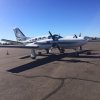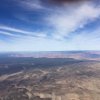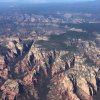Got some left seat time today in the pattern. The first flight was total fire hose and really just doing what I was told. Today was the first time I got to run the checklists and fly "on my own". No help from the right seat unless I was about to screw it up.
Engine Start -
(I'm skipping a whole bunch of preliminary items)
*Battery On.
*Check voltage
*Boost Pumps on - check annunciators
*Starter On - check annunciators
There is a very large starter/generator driven off the accessory drive of each engine. The starting amperage is huge to get these turbines started, as in 800 amps. The battery needs to get the engine RPM(Ng) to a minimum of 12% and preferably as close to 20%. Max Ng represents an RPM of 37,500 so the battery and starter has to get the rotating mass to 6,000 RPM before any fuel is added.
*Over 12% NG move condition lever to Run.
*Check Fuel flow indication
Now the fun part. Eyes must immediately go to the ITT(inter turbine temp) gauge. The goal here is to ensure you don't create a $350,000 pile of molten metal. The limit is 1090*C for two seconds. I had a new battery installed prior to delivery and I've not seen a start temp over 700*C yet. If you see the needle moving quickly you need to pull the condition lever to off right damn quickly.
*Monitor the start annunciator which will go out at 42% Ng
*Above 52% Ng turn off the starter.
*Check all engine gauges for proper indications
*Increase power to 68% Ng
*Generator switch on
Remember that starter that was just drawing 800 amps to get that motor turning? It is now a generator and will be recharging that battery to begin the start on the other side.
*After generator output on started engine is below 200 Amps repeat the steps to get the other side started.
This all happens pretty quickly and today was accomplished in about two minutes.
This plane is actually lighter on the controls for taxi than the 310. Also there is a ton of residual thrust with the power levers at ground idle. Don't pay attention and you'll be doing 50 kts in short order. Thankfully there is beta and unless you want to be buying lots of brake pads you have to use it. It doesn't take the thrust to zero, but much closer.
The pre takeoff checks in this aircraft are critical for flight safety -
1. Electric Trim check. Flight can be continued if the checks fail, but circuit breaker must be pulled for flight and you're trimming by hand. The trim is effective and runaway trim is a bad deal.
2. Overspeed Governors. There are actually three systems to ensure the prop won't over speed. This is simplified, but there are basically two prop governors that act in series and a third system that will cut fuel when it senses an over speed condition. This check entails flipping a switch which causes the secondary prop governor to have a lower limit than normal. So when you throttle up with the the system in test you can't go to the normal governed limit of 1900 RPM, but instead will stop at 1700. When the switch is released the prop will go back to 1900 and you know you have redundant control.
3. Auto feather check. This is a go/no-go item and must be checked prior to every flight. This system uses the torque sensing systems and once armed will automatically feather the prop if the torque drops below a set value. Vmc is not a pretty number in this aircraft with one not feathered and the other turning full steam. The four blade props create a huge amount of drag and in the case of an engine rolling back on the initial climb and the auto feather failing you better be on your A game or you're probably going to have a bad day.
Ok lined up ready to go. Hold the brakes, bring up the power levers to about 1000 lbs of torque, check the auto feather armed and let go. We were light today, about 1800 lbs under gross, and she shot forward with a bit of ferocity. Things are happening quickly, but a quick a quick scan of the engine gauges, get the torque closer to the limit of 1240 lbs and ... there goes 100 kts. The 310 requires a bit of a tug to leave the runway, but the conquest kind of came off by itself. This plane is very light, but stable compared to what I've flown in the past. Positive rate, gear up. Pitch up to 8* - 10* which will give about 150 kts.
I have to stress that it took me far longer to type that paragraph than it does to actually happen. It is so fast compared to what I'm used to. I leveled off at 2000 agl and we were through 200 kts in a few seconds. We tried a few different power settings to get a feel for speeds and trim conditions. It is deceiving because the plane is so much quieter and the turbines give far fewer tactile cues. I don't think this is a plane to fly by the seat of your pants. You will eventually find yourself in a place you don't want to be. Pitch, power, performance or something like that.
I was very pleasantly surprised at the flying qualities of the conquest. It was very light on the controls compared to what I'm used to in the 310, but was also more stable.
The only "gotcha" on landing is that the power on the engines doesn't come off perfectly evenly and when those big four bladed props go flat they create so much drag. You feel a very pronounced deceleration when you pull the last bit of power, and due to the unevenness, you tend to get a yaw on very short final that you must be aware of. Once you are past that the trailing link landing gear make you look like a hero. Grab a handful of levers and go into reverse and she stops quickly. We landed on a 3000 ft strip and were easily stopped by midfield with minimal braking. Sweet.
Should be flying a 600 mile xcountry on Wednesday.














